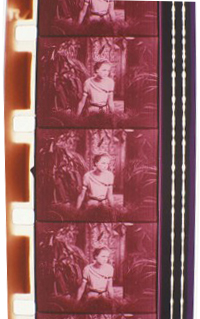This is an archive of the ArtCat Zine, 2007-2009. Please visit our new project, IDIOM.
Joseph Cornell at the Anthology Film Archives this weekend

1936, black and white film
in 16mm, 20 minutes, sound on cassette.
Courtesy of the Walker Art Center.
ESSENTIAL CINEMA: JOSEPH CORNELL
Anthology Film Archives - 32 Second Ave, New York NY
Program 1: Saturday 22 December 5pm
Program 2: Saturday 22 December 7pm
$8
Joseph Cornell, a New York native and key American surrealist, is widely recognized for his “boxes” — small assemblages constructed mostly from found materials and various ephemera and housed neatly in small, rectangular boxes. His film output is less widely known than these sculptures, something that Cornell himself has attributed to his disinclination to publicly screen his work after an incident showing his early film Rose Hobart to a packed New York gallery in 1936. In town for a large Surrealist exhibition going on at the MoMA, Salvador Dalí, while making the rounds in New York and meeting the city's artists, attended Cornell's screening. Some time through the film Dalí, by then remarkably agitated, shouted insults at Cornell and overturned the projector in a fit of rage, later explaining, to the gallery owner, “My idea for a film is exactly that... I never wrote it down or told anyone, but it is as if he had stolen it.”
Sampling continental montage techniques, Cornell proposes an often gentler and more nuanced approach to the surrealist mode than many of his European contemporaries. Comparing a film like Rose Hobart to Buñel and Dalí's Un Chien Andalou is telling in this regard. Cornell's unabashed interest in beauty and his sidestepping of the violent potential in the surrealist project, as well as any direct movements towards the erotic or the amour fou, has resulted in a distinctly American body of work. Cornell may have been the first filmmaker to compose works made primarily from “found” or appropriated footage; Rose Hobart, for instance, is constructed almost entirely from footage refashioned from the 1931 jungle B-movie East of Bonero staring the titular actress. Cornell would show the silent film with a blue filter installed on the projector's lens (tinting the film) while playing the full-length of Holiday in Brazil, an accompanying record by Nestor Amarai — an exhibition technique that is, of course, a crucial component of the work and that Anthology observes when screening the film. After the incident with Dalí, it would be Jonas Mekas, Cornell's friend and Anthology's founder, current director, and prolific vanguard filmmaker, in the 1960s who would persuade Cornell to start showing his films again. Having made them part of the Essential Cinema series, Anthology shows these works now usually at least once a year, offering a chance for cinema goers to contemplate the sometimes opaque films that, like so much avant-garde cinema, reveal themselves further with each viewing.
Alongside Rose Hobart, some of Cornell's most important work are the films constituting The Children's Trilogy (1940s – 1969) — Cotillion, The Children's Party, and The Midnight Party — the first two of which are composed of nearly the same found shots of a children's party but spliced together in different order. These films reaffirm childhood as one of Cornell's leitmotifs, a theme that the artists seemingly dismisses by affirming his interest in creating work especially for children — his last major New York exhibition, in fact, was just such a show with work hung at a child's eye level and the museum staff serving pop and cake at the opening. This interest proves to be a revealing component of his life's work when examined in relation to the concerns and interests of other surrealist artists working at that time.
Several of Cornell's later films were completed posthumously by his disciple and fellow filmmaker Larry Jordan. Cornell mostly moved away from the collage or found-footage film in his later years, creating lyrical cinema and collaborating with other artists — most notably, perhaps, with the young Stan Brakhage, with whom he had created Gnir Rednow (1955), a film composed of the out takes from Brakhage's The Wonder Ring (1955), which Cornell had commissioned as a document of New York City's Third Avenue El before it was torn down in sections. Gnir Rednow was intended to be projected from either tail-end of the film, with the projector always running forward, and underscores Cornell and Brakhage's unique understanding of cinema as a material document rather than an ephemeral tool of representation.
ZINE
HOME
TIPS / COMMENTS
CATEGORIES
CONTRIBUTORS
- Greg Afinogenov
- B. Blagojevic
- Adda Birnir
- Susannah Edelbaum
- Julie Fishkin
- Paddy Johnson
- Jessica Loudis
- Christopher Reiger
- Andrew Robinson
- Peter J. Russo
- Blythe Sheldon
- S.C.Squibb
- Hrag Vartanian
